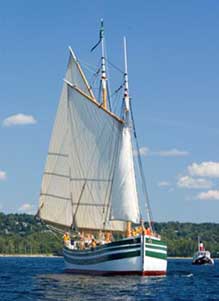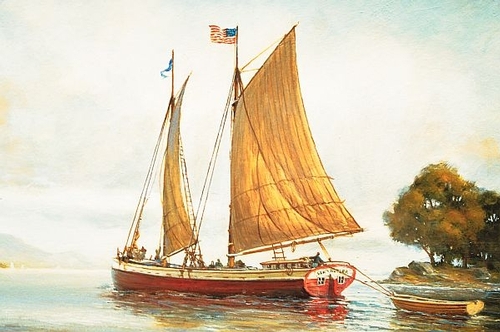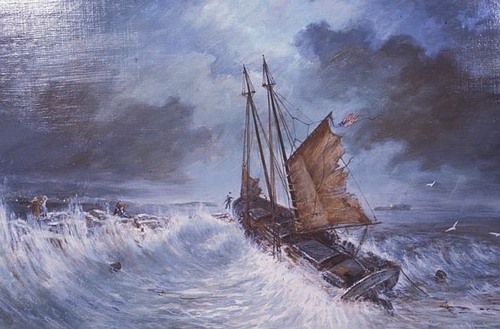Sailing canal boats were widely used in Lake Champlain due to their versatile designs allowing them to sail on open waters and pass through canals. They were a hybrid between a towed canal boat and a sailing vessel. In 1821, the British, still in control of Canada, levied a heavy tax on timber from Lake Champlain (The North American Assault, 94), so the development of a passage from Lake Champlain to the Hudson river was paramount to the success of the Lake Champlain valley timber industry. The Champlain Canal was opened in 1823 and allowed the Lake Champlain valley to prosper economically (The Economic History, 121). The canal linked Lake Champlain from Whitehall to the Hudson River north of Albany nearby the junction of the Erie Canal and the Hudson and allowed goods to be transported cheaply from the lake to New York in less than two weeks (The Lake Champlain Sailing Canal Boat, 46). This massive network of canals, in addition to adjustments to the Richelieu River in Quebec, allowed goods to flow among Quebec, the Atlantic coast via New York and the St. Lawrence Seaway, and the Great Lakes (ibid, 47). Large amounts of timber, crops, iron, and marble came from Lake Champlain.
A schematic of the Sailing Canal Boat General Butler. Lake Champlain Maritime Museum
Prior to the advent of sailing canal boats, transportation of goods from Lake Champlain was costly and slow. Any cargo passing through the Champlain Canal had to be transferred from a sailing vessel to a canal boat and back to a sailing vessel. While this was more effective than transporting goods to the Hudson River by road, it was still very slow. An entrepreneur from St. Albans, VT, saw an opportunity to re-invent boats with the ability to sail on the lake and pass through the canal to lower transportation costs significantly. While the first boat to pass through the canal was a sailing canal boat carrying wheat and potash bound for New York, it would still be nearly a decade before sailing canal boats dominated commercial transportation through Lake Champlain (ibid, 66). However, once sailing canal boats became common, the Lake Champlain economy prospered.
A sonar image of the Sailing Canal Boat General Butler wreck. Lake Champlain Maritime Museum
Settlers were attracted to the eastern Adirondacks due to the increased demand for raw materials from the region since they could be transported cheaply with sailing canal boats. Sawmills, quarries, mines, iron works, and other mercantile businesses were established on the western shore of the lake (Discovery, Navigation, and Navigators 109-110). By 1850, all timber within reasonable distance of the lake was cut, processed, and sold, but the lake was still receiving large amounts of timber from Quebec and processing it (The Lake Champlain Sailing Canal Boat, 50-51). The iron industry also benefitted greatly form the sailing canal boats, since “cheap transportation was crucial to the iron industry.” Many iron mines near the lake capitalized on returns while mines farther away failed, including Adirondack Iron Works which was producing some of the highest quality iron in the region (ibid, 52). Due to such cheap transportation, New York was producing 20% of the country’s iron by 1860 and was one of the North’s primary sources of iron during the Civil War (ibid, 54). The sailing canal boat was a significant contributor to the economic success and growth in population of the eastern Adirondacks.
Lois McClure, a recreation of an 1862-class sailing canal boat based on dimensions from the shipwreck of the General Butler. http://www.lcmm.org/our_fleet/lois_mcclure.htm
The General Butler was built in 1862 at Essex, NY which hosted one of the most prominent shipyards on the lake. Many sailing canal boats were built there (ibid, 155). By this time, sailing canal boats were beginning to lose popularity due to the advent of transportation by steam ships and the development of railroads on the western shore of the lake. However, the first owners of the General Butler profited so much from their investment that they sold the boat in three years. This can be attributed to the fact that sailing canal boats still offered the fastest mode of commercial transportation from the lake to New York, so there was still a niche market for fast transportation, especially during the Civil War (ibid, 156). Its final owner, William Montgomery, was an independent boat driver and transported marble, wood, coal, potatoes, apples, and hay from the lake to and from Canada and New York (General Butler, 13). Most sailing canal boats on the lake were operated by independent boat drivers who collectively transported marble, lumber, iron, leather, crops, maple syrup, minerals, lead, livestock, and wool. Most rock, except marble, came from the Adirondack side of the lake (The Lake Champlain Sailing Canal Boat, 53).
Artist's rendition of the General Butler. http://www.vpr.net/news_detail/85417/history-under-waves-general-butler/
Sailing canal boat operators often worked under harsh and dangerous conditions and many boats were home to families. A testament to this is the way the General Butler sank. On December 9, 1876, Montgomery was transporting 12 tons of marble from a quarry on Isle La Motte to the Burlington Manufacturing Company in Burlington with his teenaged daughter, her friend, a crew member, and an injured man from the quarry to go to the hospital. The skies looked clear over the Adirondacks before his departure, but a vicious winter storm whipped up and caused the boat’s steering to break. Montgomery quickly anchored the boat and successfully rigged a tiller to the steering post, but was unable to maneuver the boat around the harbor’s breakwater. All passengers survived, but the ship quickly sank. Historians suggest that because Montgomery brought his daughter and her friend wit him on the boat, he did not suspect a dangerous journey (ibid, 153-156). Montgomery continued operating sailing canal boats, but 26 years later to the day, found himself in an eerily identical situation while entering the Burlington harbor at the age of 72. Fortunately, he managed to steer around the breakwater with tattered sails and ice-coated rigging. Montgomery lived to 92, greatly surpassing the age expectancy of anyone living at the time, let alone sailing canal boat drivers (ibid, 157).
Artist's rendition of the sinking of the General Butler. http://www.vpr.net/news_detail/85417/history-under-waves-general-butler/





